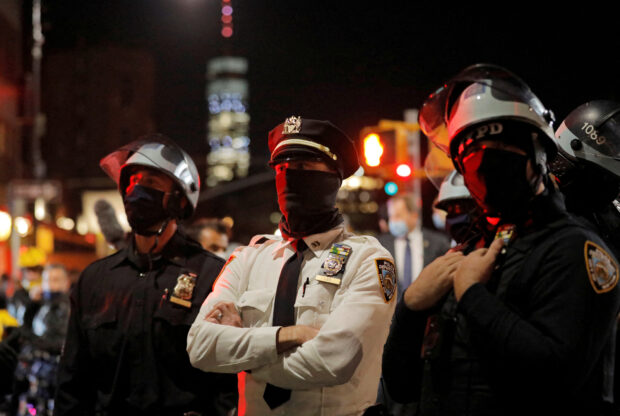To settle suit, NYPD agrees to scale back enforcement of protests

Members of the New York Police Department (NYPD) watch a Black Lives Matter protest in Manhattan, New York City, U.S. November 5, 2020. REUTERS FILE PHOTO
The New York City Police Department on Tuesday agreed to scale back its enforcement of street protests like those that erupted after the death of George Floyd in 2020, enacting a series of reforms including banning the tactic known as “kettling.”
Kettling involves creating a cordon of police officers to surround a crowd to control it. Critics say the tactic ensnares lawful protesters and innocent bystanders.
Police will also create a new senior executive role to oversee responses to demonstrations, allow the press more leeway to cover marches, and create a four-tiered response to protests designed to de-escalate conflict and prevent excessive use of force, according to a filing in U.S. District Court for the Southern District of New York.
The settlement resolves a lawsuit brought by New York Attorney General Letitia James, the Legal Aid Society and the New York Civil Liberties Union.
Those suits were filed in response to a raucous summer of protests in 2020 when police cracked down on demonstrations against police brutality and in favor of African American rights after Minneapolis police killed George Floyd on May 25, 2020. Similar protests rocked cities across the United States.
Article continues after this advertisement“Today’s settlement represents a novel approach to policing protests that, if implemented faithfully by the NYPD, will ensure that protesters are never again met with the sort of indiscriminate violence and retaliatory over-policing New York saw in the summer of 2020,” Legal Aid attorney Corey Stoughton said in the statement.
Article continues after this advertisementThe NYPD did not immediately respond to a request for comment.
The agreement reforms police policy on encircling protesters who are inadvertently or mistakenly caught up in a detention, enabling them to leave the scene, and it bans “kettling,” which the settlement describes as enclosing targeted individuals without having probable cause to detain them.
The four-tiered response protocol starts with Tier One, when a police community affairs liaison is sent to facilitate the protest and can escalate to Tier Four, when an incident commander can disperse a crowd if there is widespread criminal conduct.
RELATED STORIES